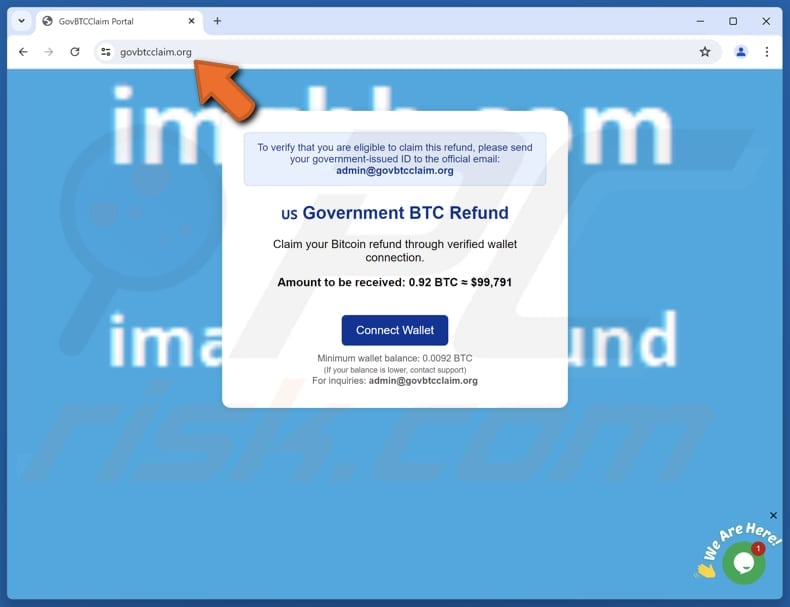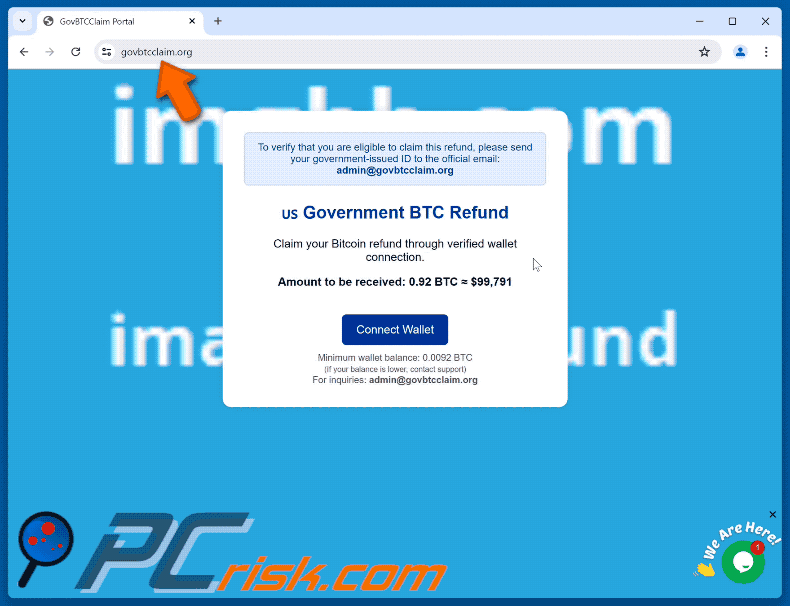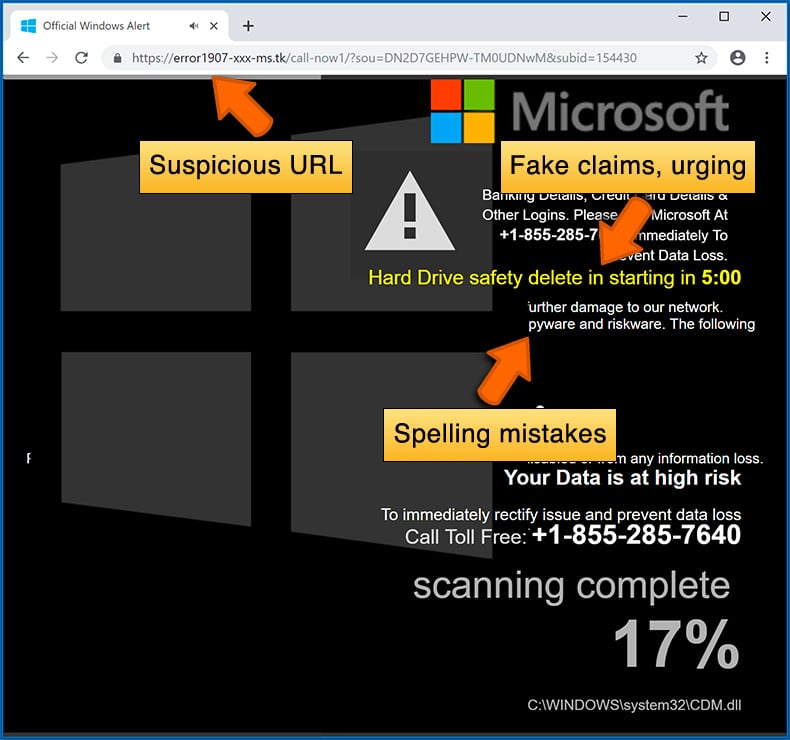How to identify scams like "US Government BTC Refund"
Phishing/ScamAlso Known As: US Government BTC Refund phishing scam
Get free scan and check if your device is infected.
Remove it nowTo use full-featured product, you have to purchase a license for Combo Cleaner. Seven days free trial available. Combo Cleaner is owned and operated by RCS LT, the parent company of PCRisk.com.
What kind of scam is "US Government BTC Refund"?
Our analysis of the site has revealed that it is a scam disguised as a platform for "claiming refunds" in cryptocurrency. Its purpose is to deceive visitors into taking actions that allow scammers to steal crypto holdings. This page should be ignored to avoid cryptocurrency theft.

"US Government BTC Refund" in detail
This scam page offers a Bitcoin refund from the US government and urges visitors to verify their eligibility by sending a government-issued ID to the provided email address (admin@govbtcclaim.org). It encourages users to connect their cryptocurrency wallets to claim a refund (0.92 BTC).
The page also states that the required minimum wallet balance is 0.0092 BTC and directs users with lower balances to contact support. This deceptive site is designed to compromise users' cryptocurrency wallets. If interacted with, it instructs to provide seed phrases, supposedly to connect wallets.
This information (if entered) is sent to scammers. Fraudsters can use it to access and drain wallets (steal cryptocurrency). Blockchain transactions are irreversible, so once funds are stolen, recovering them is nearly impossible. Consequently, victims of these scams often lose all the cryptocurrency stored in their wallets.
Therefore, it is important to be careful when encountering sites offering cryptocurrency in the form of "rewards", "refunds", or similar incentives. Engaging with scam pages can lead to the theft of personal data or digital assets.
| Name | US Government BTC Refund phishing scam |
| Threat Type | Phishing, Scam, Social Engineering, Fraud |
| Fake Claim | Users can claim refunds in cryptocurrency |
| Disguise | Legitimate government platform for claiming refunds |
| Related Domain | govbtcclaim[.]org |
| Detection Names (govbtcclaim[.]org) | Seclookup (Malicious), Full List Of Detections (VirusTotal) |
| Symptoms | Unofficial domain, lack of official verification, unrealistic claims, too good-to-be-true promises |
| Distribution methods | Compromised websites, rogue online pop-up ads, unwanted applications, rogue ad networks, adware. |
| Damage | Loss of sensitive private information, monetary loss. |
| Malware Removal (Windows) |
To eliminate possible malware infections, scan your computer with legitimate antivirus software. Our security researchers recommend using Combo Cleaner. Download Combo CleanerTo use full-featured product, you have to purchase a license for Combo Cleaner. 7 days free trial available. Combo Cleaner is owned and operated by RCS LT, the parent company of PCRisk.com. |
Similar scams in general
Scams like this trick users into revealing sensitive information and wallet access by promising free cryptocurrency (e.g., refunds). Once stolen, crypto funds are nearly impossible to recover. Thus, users should always verify the legitimacy of such offers and avoid interacting with suspicious sites to protect their crypto.
More examples of crypto-related scams are the fake "SetLayer ($SLAY) Airdrop", "Plume Airdrop", and "NAYM Token Airdrop".
How did I open a scam website?
Fraudsters employ various tactics to lead users to fraudulent websites. Scam pages can be advertised through fake or compromised social media accounts, deceptive advertisements, and hijacked websites.
Additionally, scams can be pushed via fraudulent emails containing links (or files), notifications from shady sites, adware, and malicious advertising networks. Such ad networks are commonly found on websites offering torrent downloads, adult content, illegal streaming, and similar services.
How to avoid visiting scam pages?
Exercise caution when receiving unexpected or unrelated emails or messages from unknown senders. Do not open attachments or links in such messages (unless you are sure they are legitimate). Do not click on pop-ups, advertisements, download buttons, or links found on dubious websites.
Always decline permission requests for notifications from suspicious sites. Download software and files from reliable sources like official websites or app stores. Keep your operating system and applications up to date, and regularly scan your device using trustworthy security software.
If your computer is already infected with unwanted apps, we recommend running a scan with Combo Cleaner Antivirus for Windows to automatically eliminate them.
The appearance of "US Government BTC Refund" scam (GIF):

Text on this scam website:
To verify that you are eligible to claim this refund, please send your government-issued ID to the official email: admin@govbtcclaim.org
US Government BTC Refund
Claim your Bitcoin refund through verified wallet connection.Amount to be received: 0.92 BTC ≈ $99,791
Connect Wallet
Minimum wallet balance: 0.0092 BTC
(If your balance is lower, contact support)
For inquiries: admin@govbtcclaim.org
Instant automatic malware removal:
Manual threat removal might be a lengthy and complicated process that requires advanced IT skills. Combo Cleaner is a professional automatic malware removal tool that is recommended to get rid of malware. Download it by clicking the button below:
DOWNLOAD Combo CleanerBy downloading any software listed on this website you agree to our Privacy Policy and Terms of Use. To use full-featured product, you have to purchase a license for Combo Cleaner. 7 days free trial available. Combo Cleaner is owned and operated by RCS LT, the parent company of PCRisk.com.
Quick menu:
- What is US Government BTC Refund phishing scam?
- How to identify a pop-up scam?
- How do pop-up scams work?
- How to remove fake pop-ups?
- How to prevent fake pop-ups?
- What to do if you fell for a pop-up scam?
How to identify a pop-up scam?
Pop-up windows with various fake messages are a common type of lures cybercriminals use. They collect sensitive personal data, trick Internet users into calling fake tech support numbers, subscribe to useless online services, invest in shady cryptocurrency schemes, etc.
While in the majority of cases these pop-ups don't infect users' devices with malware, they can cause direct monetary loss or could result in identity theft.
Cybercriminals strive to create their rogue pop-up windows to look trustworthy, however, scams typically have the following characteristics:
- Spelling mistakes and non-professional images - Closely inspect the information displayed in a pop-up. Spelling mistakes and unprofessional images could be a sign of a scam.
- Sense of urgency - Countdown timer with a couple of minutes on it, asking you to enter your personal information or subscribe to some online service.
- Statements that you won something - If you haven't participated in a lottery, online competition, etc., and you see a pop-up window stating that you won.
- Computer or mobile device scan - A pop-up window that scans your device and informs of detected issues - is undoubtedly a scam; webpages cannot perform such actions.
- Exclusivity - Pop-up windows stating that only you are given secret access to a financial scheme that can quickly make you rich.
Example of a pop-up scam:

How do pop-up scams work?
Cybercriminals and deceptive marketers usually use various advertising networks, search engine poisoning techniques, and shady websites to generate traffic to their pop-ups. Users land on their online lures after clicking on fake download buttons, using a torrent website, or simply clicking on an Internet search engine result.
Based on users' location and device information, they are presented with a scam pop-up. Lures presented in such pop-ups range from get-rich-quick schemes to fake virus scans.
How to remove fake pop-ups?
In most cases, pop-up scams do not infect users' devices with malware. If you encountered a scam pop-up, simply closing it should be enough. In some cases scam, pop-ups may be hard to close; in such cases - close your Internet browser and restart it.
In extremely rare cases, you might need to reset your Internet browser. For this, use our instructions explaining how to reset Internet browser settings.
How to prevent fake pop-ups?
To prevent seeing pop-up scams, you should visit only reputable websites. Torrent, Crack, free online movie streaming, YouTube video download, and other websites of similar reputation commonly redirect Internet users to pop-up scams.
To minimize the risk of encountering pop-up scams, you should keep your Internet browsers up-to-date and use reputable anti-malware application. For this purpose, we recommend Combo Cleaner Antivirus for Windows.
What to do if you fell for a pop-up scam?
This depends on the type of scam that you fell for. Most commonly, pop-up scams try to trick users into sending money, giving away personal information, or giving access to one's device.
- If you sent money to scammers: You should contact your financial institution and explain that you were scammed. If informed promptly, there's a chance to get your money back.
- If you gave away your personal information: You should change your passwords and enable two-factor authentication in all online services that you use. Visit Federal Trade Commission to report identity theft and get personalized recovery steps.
- If you let scammers connect to your device: You should scan your computer with reputable anti-malware (we recommend Combo Cleaner Antivirus for Windows) - cyber criminals could have planted trojans, keyloggers, and other malware, don't use your computer until removing possible threats.
- Help other Internet users: report Internet scams to Federal Trade Commission.
Frequently Asked Questions (FAQ)
What is a crypto scam?
A crypto scam is a deceptive scheme involving cryptocurrency that tricks individuals into taking certain actions. These scams often use fake websites, fraudulent messages, or misleading offers to lure victims.
What is the purpose of a crypto scam?
Ultimately, the goal is usually to steal cryptocurrency from unsuspecting individuals.
Why do I encounter scams?
Fraudsters use multiple methods to direct users to scam websites, including fake or hacked social media accounts, misleading ads, and compromised sites. Scams also spread through emails, deceptive browser notifications, adware, and malicious ad networks often found on torrent, adult content, and illegal streaming websites.
Will Combo Cleaner protect me from scams?
Combo Cleaner scans websites and identifies malicious ones. It detects sites that deliver scams, warns users instantly, and blocks access to protect them.
Share:

Tomas Meskauskas
Expert security researcher, professional malware analyst
I am passionate about computer security and technology. I have an experience of over 10 years working in various companies related to computer technical issue solving and Internet security. I have been working as an author and editor for pcrisk.com since 2010. Follow me on Twitter and LinkedIn to stay informed about the latest online security threats.
PCrisk security portal is brought by a company RCS LT.
Joined forces of security researchers help educate computer users about the latest online security threats. More information about the company RCS LT.
Our malware removal guides are free. However, if you want to support us you can send us a donation.
DonatePCrisk security portal is brought by a company RCS LT.
Joined forces of security researchers help educate computer users about the latest online security threats. More information about the company RCS LT.
Our malware removal guides are free. However, if you want to support us you can send us a donation.
Donate
▼ Show Discussion